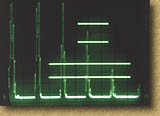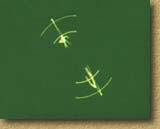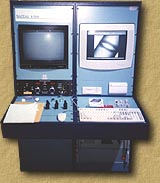NDT Methods
Ultrasonics
Eddy Current
Radiography
|
ULTRASONIC INSPECTION (UT)
 UT uses complex electronic equipment. Any material which transmits mechanical vibrations
can be tested. UT detects both linear and non-linear flaws and permits three dimensional
interpretation. Evaluation is often difficult. The UT instrument converts electrical pulses
into mechanical vibrations or waves. These waves travel across the tested specimen and
reflect from flaws because of their different acoustic nature. The returning reflected waves
are re-converted to electric energy and displayed as signals on a cathode ray tube (CRT). The
position and size of these signals correspond to the position and size of the flaws.
UT uses complex electronic equipment. Any material which transmits mechanical vibrations
can be tested. UT detects both linear and non-linear flaws and permits three dimensional
interpretation. Evaluation is often difficult. The UT instrument converts electrical pulses
into mechanical vibrations or waves. These waves travel across the tested specimen and
reflect from flaws because of their different acoustic nature. The returning reflected waves
are re-converted to electric energy and displayed as signals on a cathode ray tube (CRT). The
position and size of these signals correspond to the position and size of the flaws.
EDDY CURRENT INSPECTION (EC)
 EC instruments can be small and portable, or large multi-channel devices. The method is used only
on electrically conductive materials. An energized electric coil induces a magnetic field into
the tested specimen. The fluctuating magnetic field generates an electric eddy current. The
presence of a flaw increases the resistance to the flow of eddy currents. This change is
electronically analysed to provide flaw severity or material condition information.
EC instruments can be small and portable, or large multi-channel devices. The method is used only
on electrically conductive materials. An energized electric coil induces a magnetic field into
the tested specimen. The fluctuating magnetic field generates an electric eddy current. The
presence of a flaw increases the resistance to the flow of eddy currents. This change is
electronically analysed to provide flaw severity or material condition information.
RADIOGRAPHIC INSPECTION (RT)
 Material density and its thickness set the limits of RT's usefulness. Internal flaws are RT's
forte; its two dimensional views sometimes its drawback. RT uses penetrating radiation and
works on the principle that denser or thicker materials will absorb more radiation. The specimen
is placed between a source of radiation and a sheet of radiographic film or image amplifier.
A flaw present anywhere within the specimen will absorb less radiation than the specimen itself.
The flaw's presence and location will be indicated by an area of higher or darker exposure.
Material density and its thickness set the limits of RT's usefulness. Internal flaws are RT's
forte; its two dimensional views sometimes its drawback. RT uses penetrating radiation and
works on the principle that denser or thicker materials will absorb more radiation. The specimen
is placed between a source of radiation and a sheet of radiographic film or image amplifier.
A flaw present anywhere within the specimen will absorb less radiation than the specimen itself.
The flaw's presence and location will be indicated by an area of higher or darker exposure.
|
|

